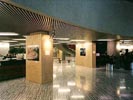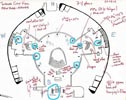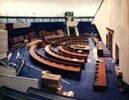thumbnails
(click on images to enlarge)
 1.installation view |
 2.installation diagram |
 3.sample panorama |
| from the installation at Toronto City Hall, 1999.
|
||
7:1 |
1999 • 7:1 |
|---|
thumbnails (click on images to enlarge) |
|
|||||||||
|
|
|
|||||||||
Project description: 7:1 On January 1, 1998 Metropolitan Toronto ceased to exist. This came about as a result of the Ontario provincial government's controversial legislation, Bill 103 and its numerous follow-ups. Six of the seven city halls of the former municipalities became, for all intents and purposes, redundant as sites of local governance. As well, the number of elected representatives to serve Toronto's 2,400,000 residents was cut from 140 to 57, thus fulfilling the provincial government's desire to reduce the effectiveness of local democratic institutions. All decisions of any consequence were centralized at Toronto's "new" new City Hall. Ironically, given the cost-cutting rationalization put forward by the province, a multi-million dollar renovation of the council chamber and offices of this building was necessitated to accomodate twice the councilors it was designed for. And so it went. In forcing through the amalgamation against the wishes of a large majority of the city's citizens, the provincial government cited the enormous savings that would surely follow the elimination of so-called "waste and duplication". In the eight years since there has been little evidence of these savings. Instead, valued social programs were cut, property taxes |
were increased by double digits, homelessness was visibly on the rise, and user fees became a reality across the amalgamated city. The truth of amalgamation is that our city was thrown into debt as the promised windfall was revealed as the shell game that it was predicted by many to be. This was anticipated by numerous previous studies on municipal amalgamations. The Conservative provincial government chose to ignore these studies. Even though the Mike Harris government was eventually turfed, their legacy has continued to hurt Toronto. The project and 1999 installation, 7:1, was undertaken to create a record of one concrete symptom of this period of extreme folly in the city's history - the gutting and renovation of the council chamber and councillor's offices. In keeping with the ideology of the period, the expansion of the council chamber to accomodate more councillors at one site necessitated the removal of several rows of public seating. |
|---|
| back to built environment overview page |
|---|
| back to projects overview page |
| back to home page |